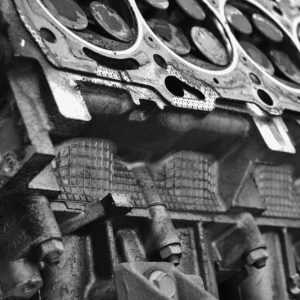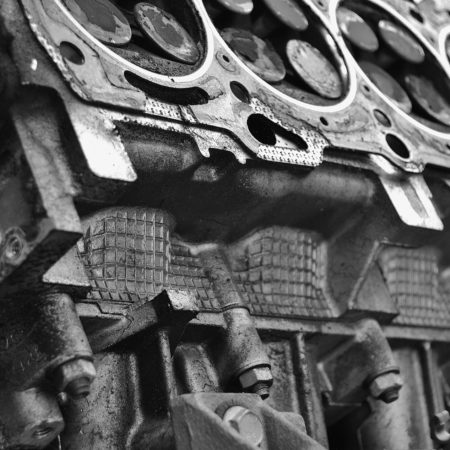 Customer information
Customer information
Metal Tech Industries was contacted by a testing facility that performs high-temperature exhaust component testing. Their high-temperature test rigs represent extreme environments to provide higher temperatures and test cycles to artificially age the components. They serve various industries, including commercial automotive, industrial, and heavy-duty engine applications where compliant exhaust systems are required.
Challenges & recommendation
Initially, the customer was using a traditional graphite gasket for these exhaust flanges. The graphite was showing oxidation and deterioration due to extreme conditions. They came to us because they know that we are an exhaust gasket material manufacturer with a variety of products.
Once contacted, we looked at a few of our materials that withstand oxidation higher than graphite does. We started with four materials with good oxidation resistance and ultimately ended up suggesting both the HT 400 and HT 514 for their testing because of their high-temperature resistance.
How products performed
After testing both materials, the customer decided on the HT 400. With the high-heat exposure comes distortion of the flanges, thus the thicker gasket was preferred. The HT 400 at 2mm thickness provided the right combination of thickness, temperature capability, economy, and overall performance to meet their needs.
Results, return on investment, and future plans
The HT 400 works very well in their applications. There are no performance issues with the gasket and it provides the sealing and handling durability that they need. It is a significant performance improvement over the graphite that wasn’t surviving, and they now have a material that will outlast their test cycle.
If you find that your gasket material has oxidation and degradation problems, contact our engineering team to discuss what our materials may do for you at sales@mtigasket.com or +1 (641) 648-5165!
Customer information
Metal Tech Industries was contacted by a testing facility that performs high-temperature exhaust component testing. Their high-temperature test rigs represent extreme environments to provide higher temperatures and test cycles to artificially age the components. They serve various industries, including commercial automotive, industrial, and heavy-duty engine applications where compliant exhaust systems are required.
Challenges & recommendation
Initially, the customer was using a traditional graphite gasket for these exhaust flanges. The graphite was showing oxidation and deterioration due to extreme conditions. They came to us because they know that we are an exhaust gasket material manufacturer with a variety of products.
Once contacted, we looked at a few of our materials that withstand oxidation higher than graphite does. We started with four materials with good oxidation resistance and ultimately ended up suggesting both the HT 400 and HT 514 for their testing because of their high-temperature resistance.
How products performed
After testing both materials, the customer decided on the HT 400. With the high-heat exposure comes distortion of the flanges, thus the thicker gasket was preferred. The HT 400 at 2mm thickness provided the right combination of thickness, temperature capability, economy, and overall performance to meet their needs.
Results, return on investment, and future plans
The HT 400 works very well in their applications. There are no performance issues with the gasket and it provides the sealing and handling durability that they need. It is a significant performance improvement over the graphite that wasn’t surviving, and they now have a material that will outlast their test cycle.
If you find that your gasket material has oxidation and degradation problems, contact our engineering team to discuss what our materials may do for you at sales@mtigasket.com or +1 (641) 648-5165!
Customer information
Metal Tech Industries was contacted by a testing facility that performs high-temperature exhaust component testing. Their high-temperature test rigs represent extreme environments to provide higher temperatures and test cycles to artificially age the components. They serve various industries, including commercial automotive, industrial, and heavy-duty engine applications where compliant exhaust systems are required.
Challenges & recommendation
Initially, the customer was using a traditional graphite gasket for these exhaust flanges. The graphite was showing oxidation and deterioration due to extreme conditions. They came to us because they know that we are an exhaust gasket material manufacturer with a variety of products.
Once contacted, we looked at a few of our materials that withstand oxidation higher than graphite does. We started with four materials with good oxidation resistance and ultimately ended up suggesting both the HT 400 and HT 514 for their testing because of their high-temperature resistance.
How products performed
After testing both materials, the customer decided on the HT 400. With the high-heat exposure comes distortion of the flanges, thus the thicker gasket was preferred. The HT 400 at 2mm thickness provided the right combination of thickness, temperature capability, economy, and overall performance to meet their needs.
Results, return on investment, and future plans
The HT 400 works very well in their applications. There are no performance issues with the gasket and it provides the sealing and handling durability that they need. It is a significant performance improvement over the graphite that wasn’t surviving, and they now have a material that will outlast their test cycle.
If you find that your gasket material has oxidation and degradation problems, contact our engineering team to discuss what our materials may do for you at sales@mtigasket.com or +1 (641) 648-5165!

